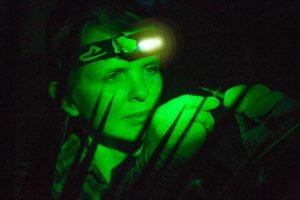Karolina Heyduk conducting research in growth chamber in both night and daylight conditions.
The following info. is provided by Heyduk
1) I cut leaf samples and use them for RNA analysis. This gives us an idea of what genes are expressed in that tissue at the time I harvested them.
2) I take gas measurements because it tells us when the plant is conducting gas exchange – CO2 into the leaf, water vapour out. For C3 plants, this happens during the day. For CAM plants, gas exchange happens at night. Gas exchange patterns are a way for us to assess whether a plant is C3 or CAM.
3) Green light is needed at night because plant stomata (pores on the leaves that allow for gases to enter and exit) respond to blue and red light. Plants are green to us because they reflect green light back while absorbing red and blue! To avoid stomatal opening, we keep to green lights. A key trait of CAM photosynthesis is that plants take up carbon at night and fix it then, as opposed to doing it during the daytime, like C3 plants. Because CAM is active at night, we have to check for gas exchange and gene expression throughout the day/night cycle to capture both C3 and CAM traits.
